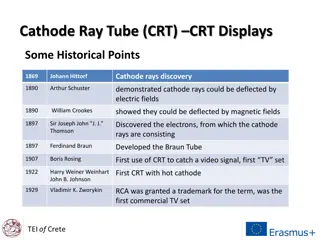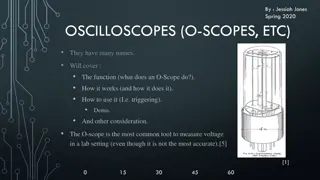Evolution of Cathode Ray Tube (CRT) Displays: Historical Milestones
The historical evolution of Cathode Ray Tube (CRT) displays is highlighted, starting from the discovery of cathode rays in 1869 by Johann Hittorf to the development of the first commercial TV set by RCA in 1929. Key milestones include the demonstration of electron deflection by electric and magnetic
0 views • 46 slides
Understanding Cathode Ray Tubes (CRT) in Oscilloscopes
Cathode Ray Tubes (CRTs) are key components in oscilloscopes, modulating and accelerating electron beams to create images of electrical waveforms, radar targets, and more. Unlike TVs, CRTs in oscilloscopes use electrostatic deflection for precise beam control. The electron gun assembly consists of a
0 views • 18 slides
Understanding Cathode Ray Tubes (CRT) and How They Work
A cathode ray tube (CRT) is a vacuum tube technology that uses an electron gun and a fluorescent screen to create images. It is commonly used in oscilloscopes, televisions, and computer monitors. CRT monitors contain millions of phosphor dots that glow when struck by an electron beam, producing visi
0 views • 11 slides
Understanding Oscilloscopes: Functions, Working, and Usage
Oscilloscopes, commonly known as O-Scopes, are essential tools for measuring AC signals with varying frequencies. They help in interpreting waveforms, correcting waveforms in real-time, and working alongside Function Generators. There are analog and digital oscilloscopes, each with specific working
1 views • 14 slides



